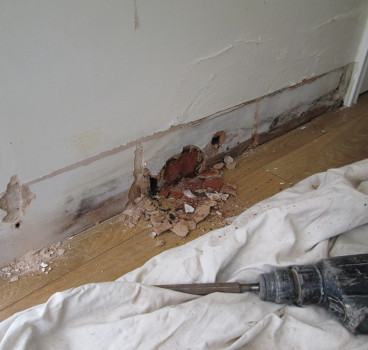Strengthening wood with nano-iron is set to change construction
Researchers at Florida Atlantic University, in collaboration with the University of Miami and Oak Ridge National Laboratory, have developed a revolutionary method to strengthen wood at the cellular level using nano-iron. This innovative approach, first detailed in the journal ACS Applied Materials & Interfaces, involves infusing wood with ferrihydrite, a naturally occurring iron oxide mineral, which can dramatically enhance its mechanical properties – giving it the potential to dramatically change the way we build in the future, writes John Ridgeway.
The research team's approach focussed on a simple yet elegant chemical process. They introduced a solution of ferric nitrate and potassium hydroxide into the wood. This triggered a reaction within the wood's cell walls, leading to the in-situ formation of ferrihydrite nanoparticles. These nanoparticles, on the scale of nanometres (billionths of a metre), were strategically deposited within the cell walls, effectively creating a wood product with similar characteristics as that of steel.
Think of wood as a bundle of tiny straws, these "straws" are the wood cells and the walls of these cells provide the wood's structural integrity. By introducing ferrihydrite into these cell walls, researchers are essentially reinforcing each individual "straw," making the entire structure significantly stronger. This targeted approach allows for a dramatic improvement in wood's properties without significantly increasing its weight.
The results of this nano-iron treatment are remarkable. The study demonstrated that the treated wood exhibited became significantly more resistant to bending, with stiffness increasing by up to 260.5%. The surface of the treated wood also became much harder, improving its resistance to dents and scratches by 127%. These improvements have transformed wood into a high-performance material, capable of withstanding forces and stresses previously unattainable.
What is Ferrihydrite?
The selection of ferrihydrite for this application is particularly noteworthy. This iron oxide mineral is abundant in nature, commonly found in soil and water. Its non-toxic nature makes it an environmentally friendly choice for wood treatment. Unlike some traditional wood treatments that rely on harsh chemicals, this nano-iron approach poses minimal risk to the environment. This is crucial for ensuring the long-term sustainability of wood as a building material. Most importantly, the development of nano-iron strengthened wood holds significant and potentially transformative implications for the construction industry.
The most immediate impact is the potential for stronger and stiffer wooden structural elements. Beams, columns and load-bearing walls made from nano-iron-treated wood could potentially support greater loads and span longer distances compared to conventional timber of the same dimensions. This could lead to more open architectural designs and potentially reduce the amount of material needed for certain structural applications.
The increased hardness translates directly to improved resistance to wear, abrasion and impact. This could be particularly beneficial in high-traffic areas, for flooring, decking and exterior cladding, leading to lower maintenance costs and a longer lifespan for wooden structures. Resistance to scratching and denting during the construction process itself could also be a significant advantage.
If nano-iron treatment allows for the use of smaller cross-sections of wood to achieve the same structural performance as larger, untreated timber, this could also lead to a reduction in the overall volume of wood required for a project. This has positive implications for resource efficiency and potentially lower transportation costs.
While the initial research focused on mechanical properties, the introduction of iron oxide nanoparticles within the cell walls could potentially offer some degree of resistance to biological degradation, such as fungal decay and insect infestation. Iron oxides are known to have some antimicrobial properties. Further research would be needed to quantify this effect in nano-iron-treated wood, but it presents an exciting possibility for increased durability and reduced reliance on chemical preservatives.
Furthermore, some metal oxides can exhibit flame-retardant properties. While the current research does not explicitly focus on this, the presence of ferrihydrite nanoparticles within the wood structure might offer a degree of enhanced fire resistance compared to untreated wood. This would require thorough investigation and testing, but it's a potential added benefit that could significantly impact building safety regulations and material choices.
In short, the enhanced properties could open up entirely new applications for wood in construction where it was previously considered unsuitable due to strength or durability limitations. This could include components in infrastructure projects, high-rise buildings (potentially in hybrid structures) and more demanding structural elements.
Transformative impacts on the construction industry:
The construction industry is a significant contributor to global carbon emissions, largely due to the use of energy-intensive materials like steel and concrete. Nano-iron-treated wood, being derived from a renewable resource, offers a potentially much lower carbon footprint. If it can replace some applications of steel and concrete, it could significantly contribute to the industry's sustainability goals and help meet net-zero targets.

However, the economic viability of nano-iron-treated wood will be crucial for its widespread adoption. Factors such as the cost of the treatment process, the availability of ferrihydrite, and the potential for reduced material usage will all play a role in its competitiveness compared to traditional building materials. If the enhanced performance and longevity translate to lower overall lifecycle costs (reduced maintenance, longer lifespan), it could become an economically attractive option.
Innovation in building design and architecture
The increased strength and stiffness could empower architects and engineers to design more innovative and aesthetically daring structures with wood. Longer spans, thinner structural elements, and more open spaces could become feasible, leading to a new era of wooden architecture.
Increased demand for sustainably sourced wood due to its enhanced properties could also revitalise the forestry industry, creating new economic opportunities in rural areas and incentivising responsible forest management practices.
In addition, the adoption of this new technology will likely create new jobs in material science, manufacturing and potentially specialised construction techniques. It will also necessitate the development of new skills and training programmes within the construction workforce.
Furthermore, the consistent and enhanced properties of nano-iron-treated wood could make it particularly well-suited for prefabrication and modular construction techniques. This could lead to faster construction times, reduced waste on-site and improved quality control.
Nano-iron-treated wood could also be used in conjunction with other materials in hybrid construction systems, leveraging the strengths of each material. For example, it could be combined with concrete or steel in specific structural elements to optimise performance and cost.
Challenges and considerations
The current research demonstrates the feasibility of the technology at a laboratory scale. However, scaling up the production and application of the nano-iron treatment to meet the demands of the construction industry will be a significant engineering and logistical challenge.
The cost of the ferric nitrate and potassium hydroxide, as well as the energy and infrastructure required for the treatment process, will also need to be economically viable for widespread adoption.
While initial results are promising, long-term studies are needed to assess the durability and stability of nano-iron-treated wood under various environmental conditions over decades. Factors like moisture exposure, UV radiation and temperature fluctuations need to be considered.
That said, the development of nano-iron strengthened wood represents a potentially game-changing innovation for the construction industry. Its ability to enhance the strength, stiffness and potentially durability of a renewable resource offers a compelling pathway towards more sustainable, efficient, and innovative building practices. While challenges related to scalability, cost and long-term performance need to be addressed, the potential benefits for reducing the carbon footprint of construction, enabling new architectural possibilities and revitalising the forestry industry are immense. As research and development continue, nano-iron-treated wood could well become a cornerstone of a more sustainable and high-performing built environment of the future. The construction industry should closely watch and actively engage with the advancements in this exciting field.
Please note: The images used to illustrate this article are AI generated and do not feature the actual product.
Additional Blogs

How construction can cut Its carbon footprint by caring for soil
Soil is often dismissed as mere dirt, but it is one of the planet’s most powerful carbon stores, holding more than all of the world’s forests combined. Yet in our rush to build, pave and develop, we...
Read moreWhat is bridging damp? How it happens and how to fix it
Bridging damp happens when moisture finds a path around the building’s damp-proof course (DPC) so it reaches your internal walls and skirting. If you see damp patches rising above the skirting or...
Read more

The silent death of the fixed-price contract
For decades, the fixed-price contract has been the backbone of construction procurement. It promised certainty with a defined scope, an agreed sum and a clear transfer of risk from client to...
Read more